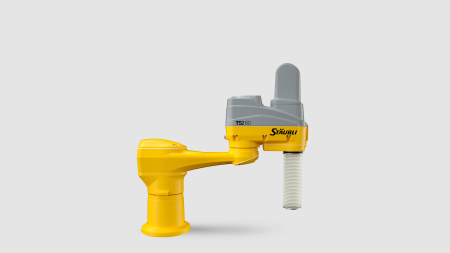SUCCESS STORY
Proven packaging expertise
Secondary packaging of parenteral drugs requires a great deal of automation expertise. Uhlmann Pac-Systeme knows how it works and relies on highly dynamic four-axis robots from Stäubli in its UPS 5 blister machine.
CUSTOMER BENEFITS
- Reliable secondary packaging
- Consistently high output
- Maximum flexibility
- Simple operation
- Highly dynamic and reliable four-axis robots
TASK
Fully automatic secondary packaging of parenteral drugs
How do you package medication sets with four components each in compliance with pharmaceutical manufacturing requirements? Uhlmann Pac-Systeme has the answer: with a UPS 5 blister machine. Their system concept, which uses hygienic Stäubli SCARA robots for cycle time-critical handling processes, can be scaled on a modular basis.
Parenteral is better: This is the guiding principle for numerous medications. It means avoiding the “detour” via the digestive tract and delivering active ingredients directly to the bloodstream or tissue, for example, with syringes, pens, and other drug delivery devices.
Uhlmann Pac-Systeme develops and manufactures the perfect secondary packaging systems for parenteral products. The injection devices used to administer the medications are typically packaged in single-dose blister packs containing several different components. Uhlmann developed the UPS 5 blister machine to accommodate this format.
Since these machines rely on robots, Uhlmann uses SCARA robots from Stäubli. These precise four-axis robots place various parenteral products into blisters formed by the UPS 5. Uhlmann’s SyPro and LiPro feeders deliver the products to each station.
Uhlmann recently supplied the longest UPS 5 to date to a pharmaceutical company that manufactures a medication set consisting of a disposable syringe and a two-component active ingredient. Each blister therefore contains four components: a syringe filled with active ingredient 1, two needles, and a vial with ingredient 2. Their combination produces a single injectable dose of the active ingredient.
SOLUTION
Three robots, four components, one blister
Uhlmann has successfully addressed this packaging challenge by utilizing three Stäubli TS2-60 SCARA robots and ensuring maximum flexibility with the addition of an extra robot station that is not currently in use. This will enable the system to package even more complex pharmaceutical products in the future.
The first workstation of the UPS 5 produces the blister cavity: A total of 10 blisters are arranged in parallel and fed to the following robot stations. The first robot station is used to place filled syringes into the blisters. A highly dynamic Stäubli SCARA TS2-60 robot reliably inserts an impressive 200 syringes per minute.
At the third station, a third TS2-60 places vials containing the second ingredient into the blister. Here, the vials are transported upright on a feeder and rotated 90 degrees at the pickup point. The TS2-60 uses its vacuum gripper to remove 10 vials at a time and place them into the corresponding blisters simultaneously. In the next steps, the UPS 5 routes the assembled blisters through automated visual inspection, seals them, and then separates them at the punching station. Only perfect blisters are passed on to the cartoning machine, which packs them into folding boxes.
- Teaser
- Teaser
CUSTOMER USAGE
Stäubli robots: The benchmark for pharmaceutical applications
Stäubli TS2-60 SCARA robots are used at every station for good reasons: This type of robot is especially prevalent in pharmaceutical manufacturing. In addition to superior hygienic design, the key factors here are high precision, long service life, and impressive dynamics, which make a decisive contribution to meeting the cycle time specifications.
The system is designed to be as simple and intuitive to operate as possible. The robot controller communicates with the higher-level Schneider PLC, and Uhlmann’s award-winning Smart Control operator terminal is used as the human-machine interface. It can be operated intuitively, much like an app.
